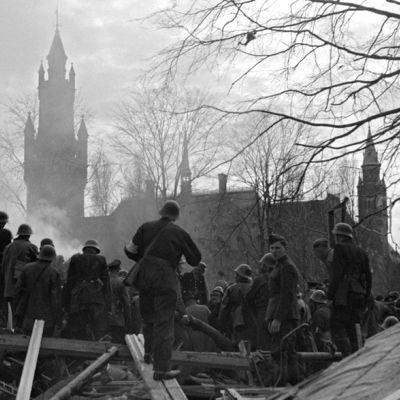This article will provide information on events in the surrounding area of the Peace Palace during the Second World War. A number of sources have been consulted to write this article. This is very much appreciated. Special thank you to Jacobine Wieringa for all aid and assistance.
Damage, Devastation and Shortages
Bombings and the launching of the “Vergeltungswaffe” (retribution weapons, V-2 missiles) from The Hague left their marks in the city. The Peace Palace also did not weather the war without a scratch, although it was mostly limited to glass- and interior damage.
The bombing of the Rijksinspectie van de Bevolkingsregisters (Government Inspection of the Population Registers) in the Kleykamp Building on 11 April 1944, located just across the Peace Palace, was an expertly executed attack by the RAF. Although the targeted building was almost completely demolished, the Peace Palace remained in tact.[18]
As the war continued and local circumstances deteriorated, the garden was used to grow vegetables in order to alleviate the suffering, while a number of trees were sacrificed to meet the increasing need for fuel. Mr. Eysinga sometimes received from his Frisian family estate Boschoord shipments of potatoes and fire wood, which were generously handed out.[19]
Liberation
After the liberation on 5 May 1945 it was possible to make up an overview of the damage. Although the Peace Palace had mostly weathered the war, the immaterial damage was extensive; lives had been lost and dreams were destroyed. Ms. Ada Belinfante immediately sent a message and after 1945 she returned to the Netherlands. The staff members who had been incarcerated in Germany returned home after the liberation.
The war was over and the reconstruction could begin.
Article by C. van Tol
